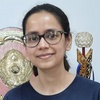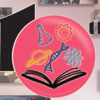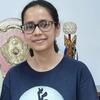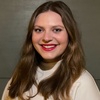
by Isabella Goetting, ComSciCon-Triangle 2022
Imagine a pervasive disease is consuming the world, with the molecular design of a cure only one click of a computer program away. Just one problem: it will take hundreds, if not thousands or even millions, of years for the program to run. Thankfully, scientists are working on a solution that could not only speed up computer simulations to design new medicines, but also address other problems that require a large amount of computational power (think of cracking security codes, sorting databases, etc.). A completely new type of computer, called “quantum computers,” offers this solution.
In classical computers, like the laptop you might have at home, zeros and ones encode information, called “bits.” Quantum computers use “qubits” instead, in which packets of data can exist as some combination of zeros and ones. This means qubits can live in a bunch of states in between one and zero. We call this the “superposition principle.”
Consider tossing a quarter. When the quarter spins in the air, you do not know with complete certainty that it will land on heads. However, you do know it will land on heads with a 50% chance. So, when it flips in the air, we can think of the coin as living in a “superposition” of both heads and tails. When it finally lands, i.e. you make a measurement, its superposition collapses to just one state, either heads or tails. This analogy can extend to a weighted coin, such as having a heavier side and thus increasing the probability to land on that side, or if you use a dice instead and have a superposition of six possible states.
Now, imagine you have two special quarters. You place one in California and the other in North Carolina, for example. These quarters share the unique correlation that when you flip one, it affects the outcome of the other’s flip. We call them “entangled.” For example, let’s say my friend lives in California and I live in North Carolina, and we toss both quarters at the same time. If my quarter lands on heads, then I know my friend’s quarter must land on tails! I know this without ever communicating with my friend. Einstein coined this term “spooky action at a distance.”
When used in a skillful and clever manner, both entanglement and the superposition principle can help speed up calculations. However, simply using quantum principles does not automatically make computations faster. At this time, it is best to address some common misnomers.
Quantum properties provide the potential to speed up calculations–they do not guarantee it. One might initially think that the superposition principle allows for some sort of parallel computing capability by running all of the possible calculations at the same time so that you obtain all the results at once. But remember, once you make a measurement, your superposition collapses to just one state (your quarter lands on either heads or tails, not both), so you would still only get one answer out at the end. Instead, you want to utilize quantum properties to extract some sort of information about the problem you are trying to solve, and this information helps speed up calculations. You want to get information without collapsing your superposition of states, so you cannot make direct measurements on your qubits. Consequently, a quantum computer uses some combination of quantum principles to figure out a way to achieve a global understanding about your problem and uses that to take a shortcut with your calculation.
(If this confuses you, that is perfectly fine. It is difficult to understand the complexities of quantum processes, or “algorithms,” without getting into the nitty-gritty of the mathematics involved. That’s a topic for another time! For now, if you are interested in learning about this in more depth, I suggest checking out IBM’s Qiskit.)
Although many different methods to create quantum computers exist, I will focus on one type that uses charged atoms, or “ions,” that have discrete energy levels. Think of these energy levels as unequally spaced steps on a ladder. Some steps require a bit more energy for you to reach, and some you can reach without exerting much effort. Lasers of certain frequencies corresponding to each level can excite the ion to different energy levels. You can define one level as your “zero” state and another level as your “one” state, thus defining your “qubit.” Lasers can then manipulate these ions by putting them into different states, hence making them do calculations similar to how our classical computers use bits of information to run various processes.
Because ions have a net electric charge, electric and magnetic fields affect them. By creating and tuning these fields to specific configurations, scientists can trap equally spaced ions in a single line formation inside of a vacuum chamber where the ions live. However, this net charge means the ions can “talk” to each other as well. When too many ions join one line, they can cause too much chatter, or “noise,” for scientists to accurately carry out calculations. Thus, researchers must come up with a way to have a lot of qubits without a lot of noise. Connecting a bunch of smaller quantum computers together to create one large quantum computer provides a way to accomplish this.
A possible scheme to connect quantum computers involves entangling ions with tiny packets of light, called “photons.” Remembering the previous coin analogy about entanglement, this means measuring an entangled photon will provide us with information about the ion. Sending a photon from one chamber to another can move information from the two physically separated chambers. This photon is entangled with the ion from the first chamber. We can then swap the entanglement from the photon to the other ion, allowing the separated ions to talk to each other! This method has the potential to scale up the number of qubits in trapped ion quantum computers while still minimizing the chatter between ions.
If scientists continue to increase the entanglement rate and minimize the noise in their system, then they can produce an efficient trapped ion quantum computer! While a lot of progress remains, witnessing the rapid development of this field makes for an exciting time.
Great! So, why should you care? Will you use these quantum computers one day? You actually can right now! Many companies developing quantum computers, such as IonQ or IBM, offer a cloud service in which you can run your own quantum algorithms. This still may not seem especially relevant to someone not interested in computer coding. While the actual technology may target researchers and big industry, the outcomes from them using quantum computers will certainly affect your life. Researchers can use this new tool to create novel medicines, banks can develop new security for your bank account, and the list goes on and on.
Watch out world; quantum computers are lighting up the path to innovation!
----------------------------------------------

Twitter: @izzyg17138
TikTok: @iontrapqueens
LinkedIn: https://www.linkedin.com/in/isabella-goetting/





